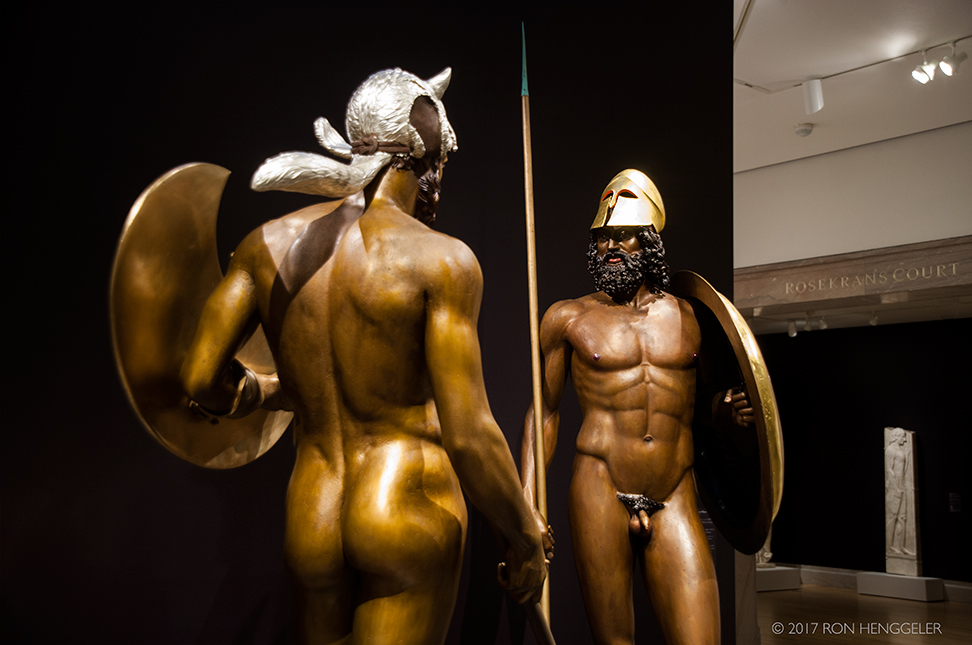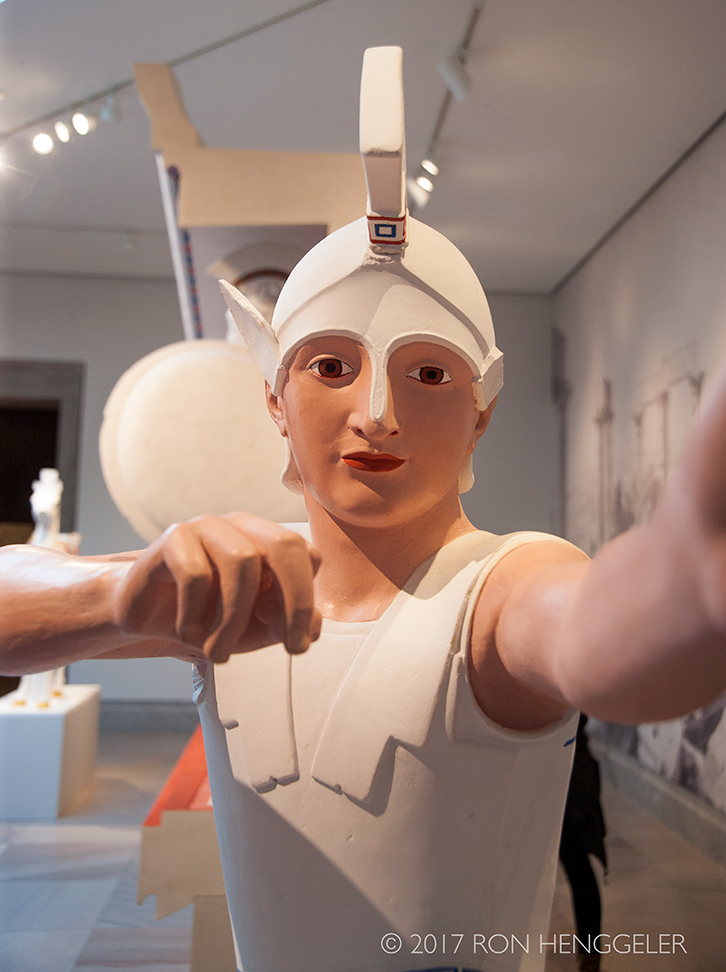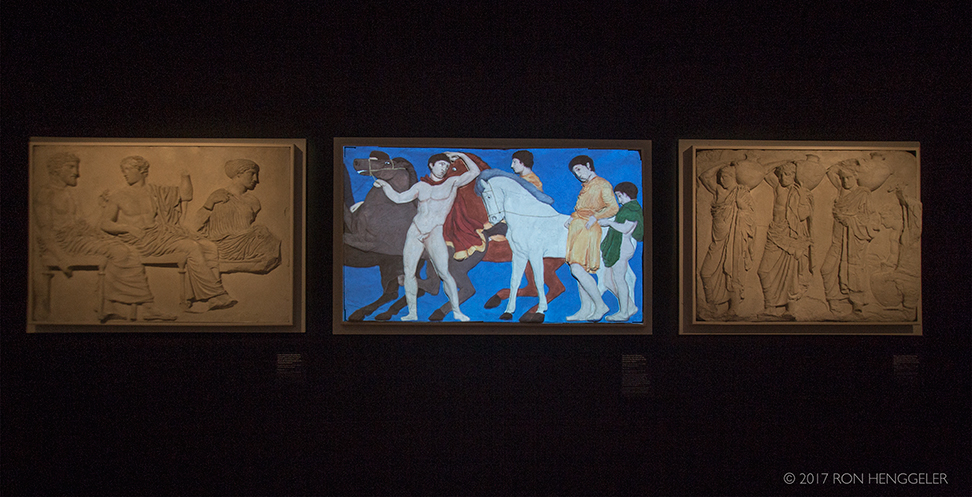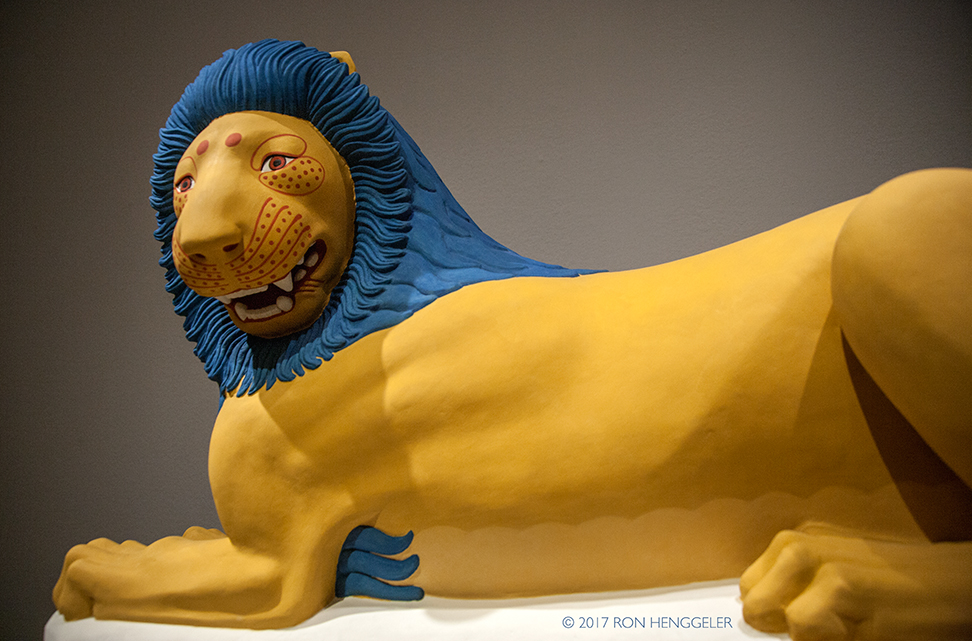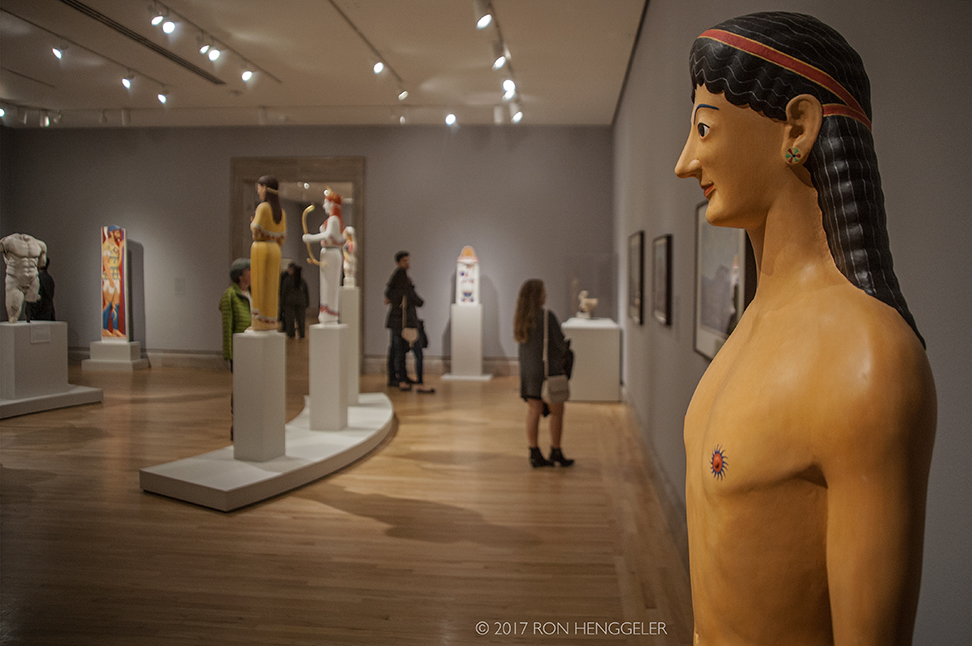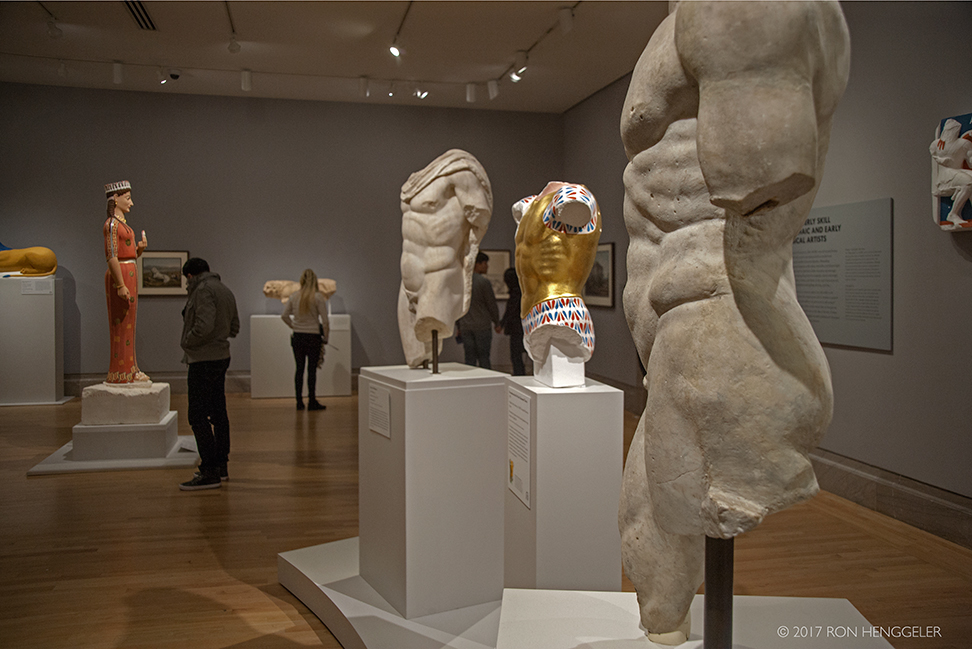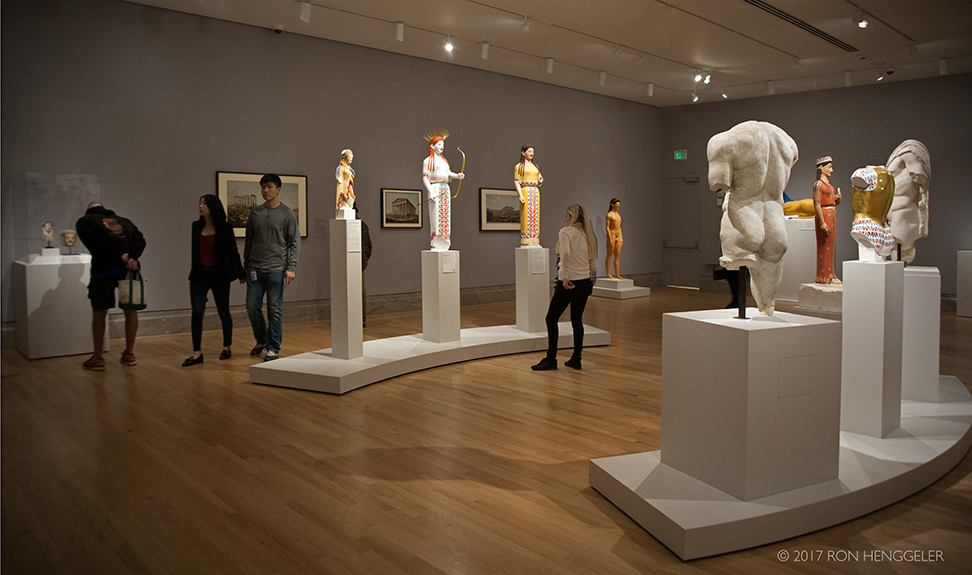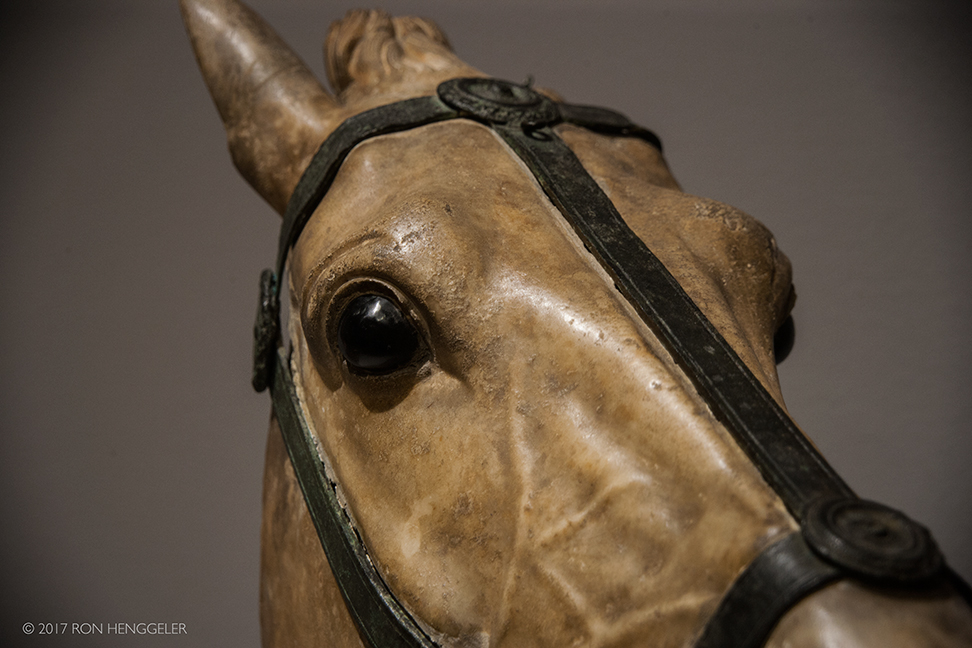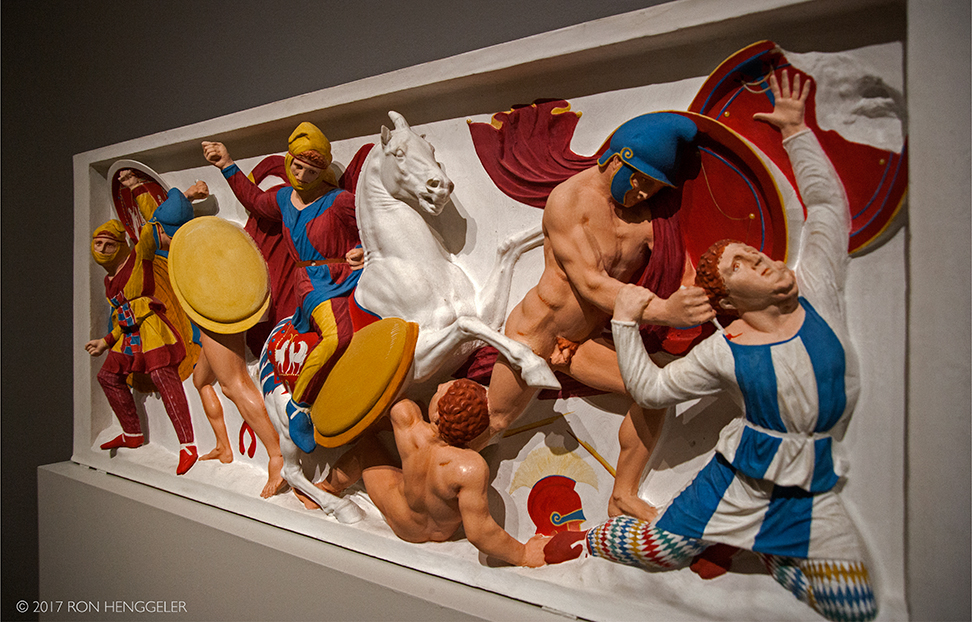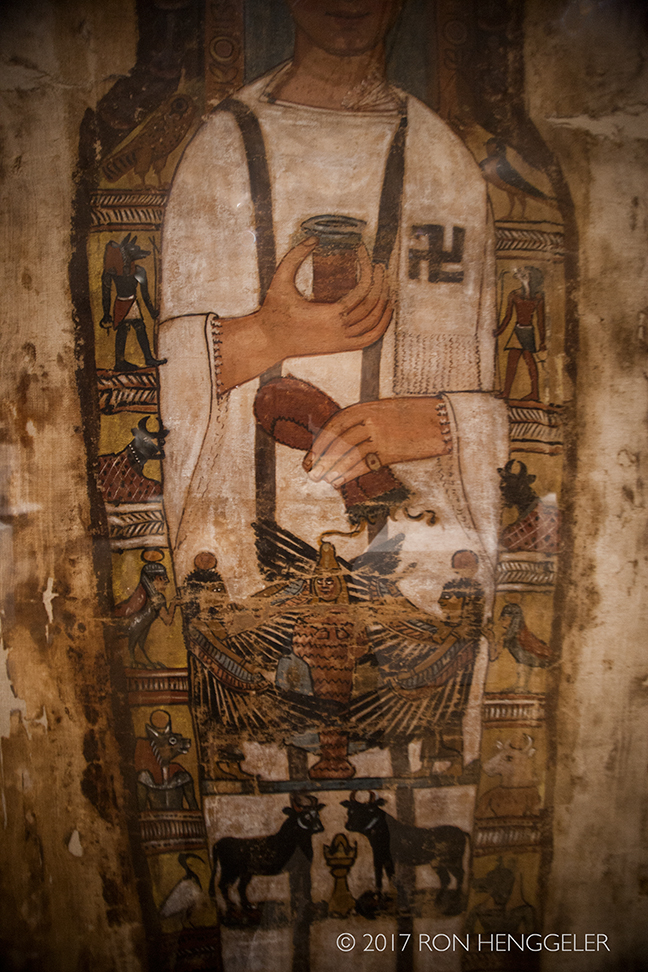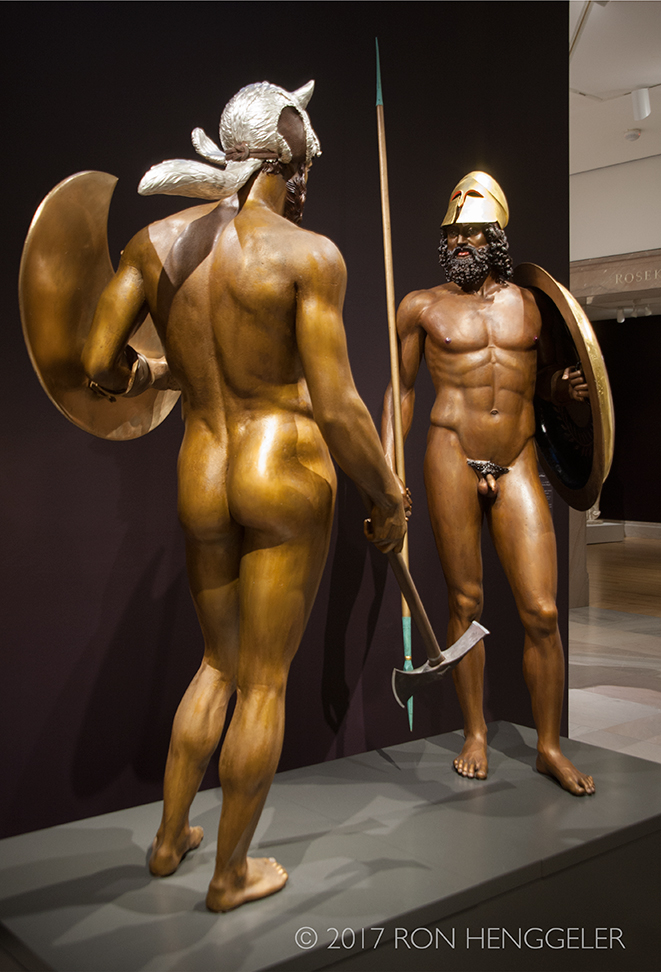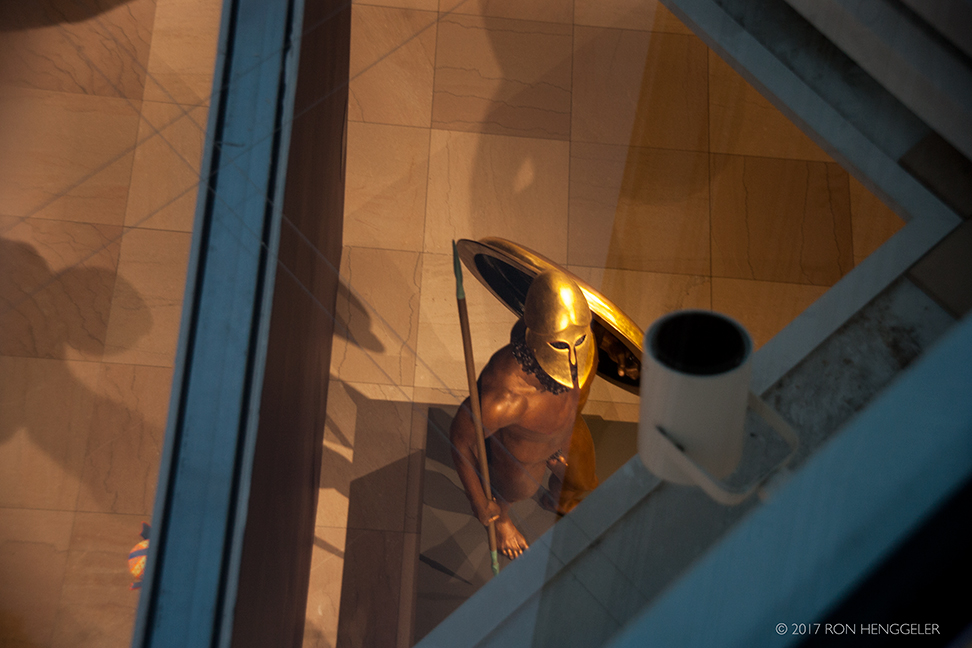RON HENGGELER |
November 9, 2017
Gods in Color: Polychromy in the Ancient World
at the Legion of Honor
October 28, 2017 – January 7, 2018
Last Sunday, Dave and I went to see a new show that has recently opened up at the Legion of Honor Museum in San Francisco.
Here are some of my photo impressions from the show.
Gods in Color: Polychromy in the Ancient World offers an astonishing look at Classical sculpture swathed in their original vibrant colors questioning the perception of an all-white "classical" ideal. Ancient sculpture and architecture from Greece and Rome is revealed as intended—garishly colorful, richly ornamented, and full of life—along with original sculpture from the Near East, Egypt, Greece, and Rome against the backdrop of the Legion of Honor's neoclassical building.To find out more about the exhibition, explore this digital offering from the Legion's friends at the the Liebieghaus in Frankfurt.(The above text was exerpted from: The Legion of Honor) |
|
Reconstruction of Riace Warriors B and A, 2016 and 2015Not only were marble sculptures polychromed in antiquity, bronze ones were also. |
Reconstruction of Riace Warriors B and A, 2016 and 2015Not only were marble sculptures polychromed in antiquity, bronze ones were also.In the two Riace Warriors the illusion of sun-tanned skin was achieved by the application of numerous layers of a greatly thinned asphalt varnish to which a little red pigment had been added. Their extremely lifelike appearance is produced by their elaborately crafted stone eyes, their copper nipples and lips, and their teeth plated with silver foil. In scientific investigations of the originals and the creation of the reconstructions it was determined that the one warrior is Erechtheus, the son of the goddess Athena, the other Eumolpos, the son of Poseidon. |
Reconstruction of Riace Warrior B, 2015 |
Reconstruction of Riace Warrior B, 2015 |
Reconstruction of Riace Warrior A, 2015 |
Reconstruction of Riace Warriors B and A, 2016 and 2015 |
Detail of Reconstruction of Riace Warrior B, 2016 |
Reconstruction of the head of Riace Warrior A, 2013 |
The archaic figures high up on the west gable of the Aphaia Temple were once readily visible from afar, thanks to their colorful painting. An important effect, for the narratives of gods, heroes, and Greek history were meant to be precisely conveyed in sculptures. Ancient artists had to consider the distance between viewer and work it into the design of their figures. It was only through painting that the necessary visual contrast could be achieved.This text is respectfully taken from the infromative and enlightening web site: Liebieghaus |
Reconstruction of a horseman, 2007Original: Greek Athens, ca. 490 BC |
The archer "Paris" from the West Pediment of Aphaia Temple in Aigina, color reconstruction, variant B (2006)This text is respectfully taken from the infromative and enlightening web site: Liebieghaus |
|
Reconstruction B of a Trogan archer, west pediment of the Temple of Aphaia, Aegina, 2005Original: Greek, Aegina, ca. 480 BC |
|
A colorful bowman aims his arrow at an invisible foe. The marble sculpture is part of a figural group that adorned the west gable of the Aphaia Temple in Greece.This text is respectfully taken from the infromative and enlightening web site: Liebieghaus |
|
Presumably the bowman was Paris, the Trojan prince. He is one of the most famous heroes in Greek mythology, who with his abduction of the beautiful Helen triggered the Trojan War.This text is respectfully taken from the infromative and enlightening web site: Liebieghaus |
Reconstruction of a section of the west pediment of the Temple of Aphaia, Aegina, 2005Original: Greek, Aegina, ca. 480 BC |
|
Detail of,Reconstruction B of a Trogan archer, west pediment of the Temple of Aphaia, Aegina, 2005Original: Greek, Aegina, ca. 480 BC |
|
In the 18th century there was already considerable debate about the extent to which ancient architecture and sculptures were painted. Two centuries later technical investigations with ultraviolet light and glancing light are providing new evidence about ancient polychromy. Investigations carried out in Munich’s Glyptothek in the 1960s resulted in important findings. In the 1980s a group of researchers associated with the archaeologist Volkmar von Graeve studied the polychromy of ancient works of art with the help of modern technological aids. At the time, Vinzenz Brinkmann was a member of von Graeve’s team. Later, as head of the Liebieghaus’s Department of Antiquities, he brought the research subject to Frankfurt.This text is respectfully taken from the infromative and enlightening web site: Liebieghaus |
Reconstruction C of a head of a warrior, east pediment of the Temple of Aphaia, Aegina, 2005Original: Greek, Aegina, ca. 480 BC |
Reconstruction B of a head of a warrior, east pediment of the Temple of Aphaia, Aegina, 2005Original: Greek, Aegina, ca. 480 BC |
Pure marble white – this is the impression that stands out when we now look at sculptures from Greek and Roman antiquity in museums. But it's misleading. The figures of gods and heroes were once painted in brilliant colors. Why is this so little known to this day? The Liebieghaus Skulpturensammlung has been studying the original painting of antique sculptures for many years and leads research in the field.This text is respectfully taken from the infromative and enlightening web site: Liebieghaus |
|
Reconstruction of Antiope and Theseus, west pediment of the Temple of Apollo Daphnephoros, Eretria, 2005Original: Greek, Eretria, ca. 490 BC |
Reconstruction of a Greek archer, west pediment of the Temple of Aphaia, Aegina 2005Original: Greek, Aegina, ca. 480 BC |
|
Detail of:Reconstruction of a Greek archer, west pediment of the Temple of Aphaia, Aegina 2005Original: Greek, Aegina, ca. 480 BC |
Detail of:Reconstruction of a Greek archer, west pediment of the Temple of Aphaia, Aegina 2005Original: Greek, Aegina, ca. 480 BC |
|
|
|
|
|
Reconstruction of an Ionic capital, Agora of Athens, 2016Original: Greek, Athens, ca. 430 BC |
The Parthenon, looking east from Propylaea, 1803Sepia on paper by Simone Pomardi |
Acropolis looking east from near Propylaea, 1805Watercolor on paper by Simone Pomardi |
Parthenon, westen pteron, looking south 1805Watercolor on paper by Edward Dodwell |
|
|
Reconstruction of Artemis, 2010Original: Roman, Pompeii, 1st century AD |
Detail of:Reconstruction of Artemis, 2010Original: Roman, Pompeii, 1st century AD |
Detail of:Reconstruction of Artemis, 2010Original: Roman, Pompeii, 1st century AD |
For more detailed information, be sure to visit: The Liebieghaus |
Cast of kourou from MelosOriginal: Greek, Melos, ca. 330 BC |
Cast of a horse and riderOriginal: Greek, Athens, ca. 490 BC |
Cast of a horse and riderOriginal: Greek, Athens, ca. 490 BC |
Cast of a horse and riderOriginal: Greek, Athens, ca. 490 BC |
Reconstruction of Antiope and Theseus, west pediment of the Temple of Apollo Daphnephoros, Eretria, 2005Original: Greek, Eretria, ca. 490 BC |
|
|
|
Cast of a caryatid, Erechtheion on the Acropolis, AthensOriginal: Greek, Athens, ca. 421-406 BC |
|
Aegina, Aphaia Temple from the southeast, 1805Watercolor on paper by Simone Pomardi |
|
Reconstruction of the grave statue of Phrasikleia, 2010Original,Greek, Merenda, ca. 520 BC |
Reconstruction of the grave statue of Phrasikleia, 2010Original,Greek, Merenda, ca. 520 BC |
Reconstruction of the grave statue of Phrasikleia, 2010Original,Greek, Merenda, ca. 520 BC |
|
|
Lion near Hymettos, looking north towards Mount Pentele, 1805Watercolor over graphite by Edward Dodwell |
Statue of a lionGreek, ca.350 BCmarble |
Reconstruction of a lion, 2012Original, Greek, Loutraki, ca. 550 BC |
|
Detail of: Reconstruction of a lion, 2012Original, Greek, Loutraki, ca. 550 BC |
Reconstruction of the Kouros of Tenea, 2015Original, Greek, Tenea, ca. 530 BC |
Detail of: Reconstruction of the Kouros of Tenea, 2015Original, Greek, Tenea, ca. 530 BC |
|
Detail of: Reconstruction of the Kouros of Tenea, 2015Original, Greek, Tenea, ca. 530 BC |
Detail of: Reconstruction of the Kouros of Tenea, 2015Original, Greek, Tenea, ca. 530 BC |
|
|
|
Reconstruction of the Peplos Kore, 2005Original, Greek, Athens, ca. 530 BC |
Detail of: Reconstruction of the Peplos Kore, 2005Original, Greek, Athens, ca. 530 BC |
Figure in the left foreground:Reconstruction B of the Peplos Kore, 2005. Original: Greek, Athens, ca. 530 BC; New Acropolis Museum, Athens. Reconstruction: plaster cast with natural pigments in egg tempera, 53 1/2 in. (136 cm) height. Liebieghaus Sculpture Collection (Polychromy Research Project), Frankfurt |
Detail of: Reconstruction B of the Peplos Kore, 2005. Original: Greek, Athens, ca. 530 BC; New Acropolis Museum, Athens. |
|
Backside of the reconstruction of the grave statue of Phrasikleia, 2010Original,Greek, Merenda, ca. 520 BC |
|
|
The Theseion (Temple of Hephaistos) Athens 1805Watercolor on paper by edward Dodwell |
Color reconstruction B of the ‘Cuirass Torso’, 2005Liebieghaus Skulpturensammlung, Polychromy Research Project |
|
Reconstruction of the Chios Kore, 2012.Original: Greek, Athens, ca. 520 BCAcropolis Museum, Athens. |
|
Reconstruction of the east frieze of the Siphnian Treasury at Delphi, 2006/2012.Original: Greek, Delphi, ca. 520 BC |
|
|
|
Detail of: Grave stele of Poseides and his wifeGreek, ca. 275 BCmarble |
Detail of: Grave stele of Poseides and his wifeGreek, ca. 275 BCmarble |
Head of a horseRoman, ca. 1st century AD, with 19th century restorationsMarble |
Head of a horseRoman, ca. 1st century AD, with 19th century restorationsMarble |
|
|
Reconstruction of Alexander the Great from the Alexander Sarcophagus, 2013Original: Greek, Sidon, ca. 320 BC |
|
Alexander Sarcophagus, Persian Battle (short side), DetailThe Alexander Sarcophagus presents a new animation typical of the art of the Hellenistic period: the seemingly lifelike sculptures were captured in motion – with fluttering garments, expressions distorted in fright, and powerful gestures.This text is respectfully taken from the infromative and enlightening web site: Liebieghaus |
Alexander Sarcophagus, Persian Battle (short side), DetailThe sculptures on the sarcophagus, which dates from the 4th century B.C., depict two episodes from the life of Alexander the Great. The numerous figures celebrate his heroic deeds, even though the ruler himself was not buried in the elaborate sarcophagus: detailed reliefs picture Alexander as conqueror of the Persian Empire and in combat with a lion, a stag, and a panther.In the highly dramatic scenes the ruler is the only one depicted riding a horse. Whereas his Greek-Macedonian forces are depicted either nude or wearing simple, monochrome garments, the Persians wear colorfully patterned trousers and shirts. Their diamond-shaped ornaments recall the clothing of the bowman Paris.This text is respectfully taken from the infromative and enlightening web site: Liebieghaus |
|
Season sarcophagusRoman, AD 260-280Marble |
|
For more detailed information, visit: The Liebieghaus |
|
Reconstructions of Cycladic figures, 2006Original: Greek, Early Cycladic II ca. 2700-2400 BC |
|
Entrance to the show, Gods in Color, at the Legion of Honor |
|
Detail of: Reconstruction of Riace Warrior B, 2015 |
Detail of: Reconstruction of Riace Warrior B, 2015 |
For more detailed information, be sure to visit: The Liebieghaus |
|
|
The numerous reconstructions produced by Vinzenz Brinkmann and his wife, the archaeologist Ulrike Koch-Brinkmann, illustrate most impressively for modern viewers the sculptures’ original polychromy. They were first exhibited in Munich’s Glyptothek in 2003, in the exhibition “Gods in Color.” In 2008 that successful exhibition was presented in the Liebieghaus Sculpture Collection in Frankfurt am Main. It is now touring around the world, and has meanwhile cast more than two million visitors under its spell. With additional reconstructions, each presentation provides new information about ancient polychromy and brings the once multicolored sculptures to life again. An exciting journey that is by no means ended.For more detailed information, be sure to visit: The Liebieghaus |
At closing time, the show Gods in Color, as seen by looking down into the skylight which is located in the center of the Legion of Honor Courtyard |
For more detailed information about the reconstructions, be sure to visit: The Liebieghaus |
Newsletters Index: 2017, 2016, 2015, 2014, 2013, 2012, 2011, 2010, 2009, 2008, 2007, 2006
Photography Index | Graphics Index | History Index
Home | Gallery | About Me | Links | Contact
© 2017 All rights reserved
The images are not in the public domain. They are the sole property of the
artist and may not be reproduced on the Internet, sold, altered, enhanced,
modified by artificial, digital or computer imaging or in any other form
without the express written permission of the artist. Non-watermarked copies of photographs on this site can be purchased by contacting Ron.







